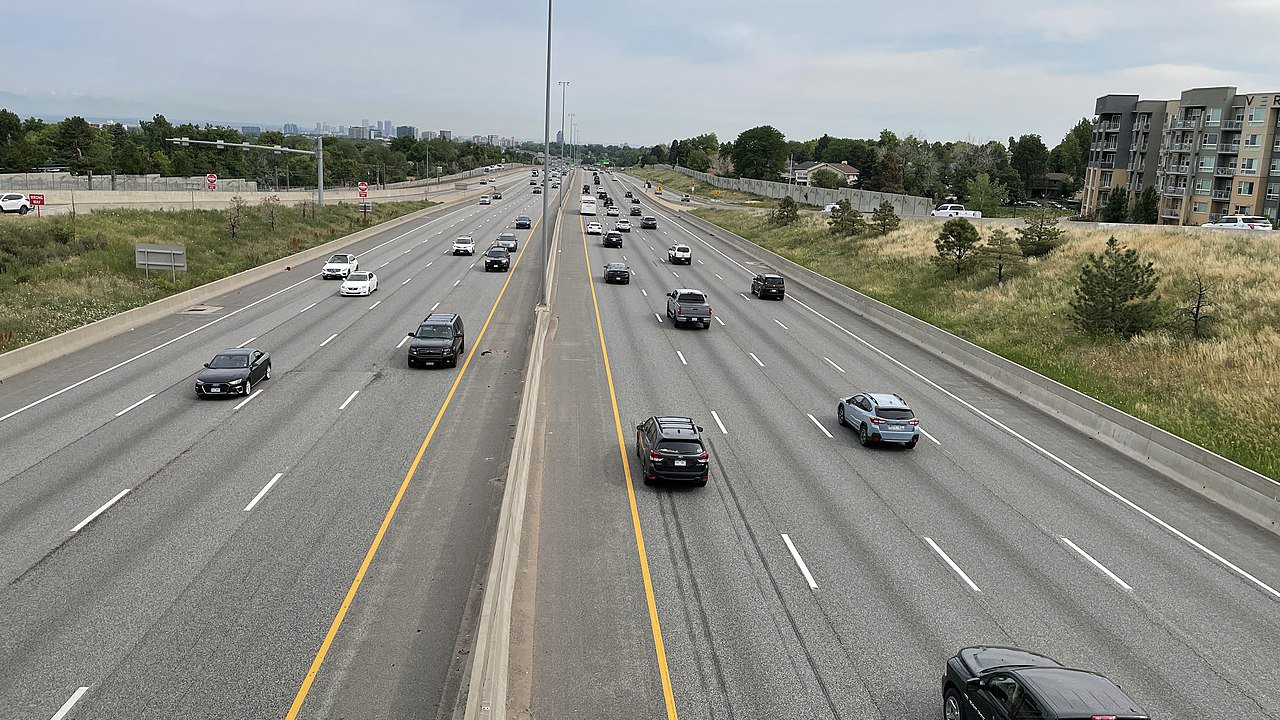Denver Residents Won’t Be Satisfied Until I-25 Ramp Project Is Officially Canceled
I-25 in Denver, CO. (Source: Wikimedia Commons.)
In February, the Denver Department of Transportation and Infrastructure (DOTI) announced plans to add “safety improvements for people who walk, bike and roll” to a controversial project that would rebuild the interchange of Interstate 25 and Broadway. In that same announcement, DOTI even expressed interest in abandoning rebuilding the interchange altogether, referred to as the South Broadway & I-25 Improvement Project. Residents critical of the interchange rejoice at DOTI's words, but fear that the project—which has loomed over Denver since the 2000s—might still possess enough momentum to move forward, despite opposition.
The project originally took shape in 2006 and lay dormant until 2020, according to neighborhood advocates. Even the project’s 2008 Environmental Impact Statement (EIS), a mandatory assessment that outlines the impact of a proposed project on its surrounding environment, is still cited in the project’s 2023 iteration. In a 2022 letter addressed to DOTI personnel, the Lincoln Broadway Corridor Registered Neighborhood Organization described the project as “designed based on Denver’s past, not the future.”
Not only has the neighborhood evolved in the intervening years since the EIS was drafted, the letter argues, but the city’s goals have shifted, as well. The RNO outlines how the South Broadway & I-25 Improvement Project is inconsistent with numerous approved plans for Denver, including Blueprint Denver, Metro Vision 2030, and Denver’s Vision Zero 2030 goals. All of these plans, in their respective ways, outline a vision for Denver that is multimodal, safer for pedestrians and cyclists, and flexible to the urban needs of the fast-growing city. “Neighbors are choosing to walk and bike more than when the study and designs for this project were first created,” the Lincoln Broadway Corridor Registered Neighborhood Organization pointed out in its letter.
Lincoln Street, a corridor in the project’s scope, is part of the “High Injury Network,” meaning it is part of 5% of Denver’s streets where 50% of traffic deaths occur. Broadway (known as South Broadway locally) also maintains a prominent place in Denver’s crash data from the last decade. Locals note that in recent years, traffic on the two roads is largely composed of people bypassing the neighborhood, which serves as an entry point into downtown Denver from its southern suburbs.
Brittany Spinner, Vice President of the Lincoln Broadway Corridor Registered Neighborhood Organization, resides on Lincoln Street, one block from Broadway. When she first moved there, she thought, “Oh, all these businesses are just one block away from us—how convenient,” only to realize that the design of the area made it impossible to feel safe crossing the street. “Even the front yard felt like a highway.”
That’s why the apparent willingness to abandon the project altogether was huge news for those like Spinner, who has been battling this interchange between work and raising a family. She and Amy Kenreich, President of the West Washington Park Association have been instrumental in distilling the consequences of the project to the general public since it resurfaced in 2020. For one, they’ve been routinely translating DOTI’s promises into plain language: the “improved pedestrian crossings” would mean crossing up to 19 lanes to access the light rail station.
Armed with archival photos of what Lincoln and Broadway once were, they also make a case for what the corridor could be. The side-by-side comparisons are jarring. Images of Lincoln Street dated before the 1970s depict many of the same homes, the same grid layout, but an entirely different set of values: the sidewalks are wide and lined with trees. In 2023, the residential street accommodates traffic via the nearby highway and consequently, resembles a “stroad”—that is, a hybrid of a street and a road that fails to perform the functions of either well, instead endangering all road users in attempting to be “the futon of transportation.”
“This makes me more than happy,” said Kenreich in response to DOTI’s news. “We’ve baked up this degree of car dependency where we don’t have a good alternative, so realistically, this is a good and collaborative solution,” she adds, admitting that she’d prefer to see less lanes and more places. “Though, I would love to know today that we’re never going to rebuild that ramp.”
Spinner is equally hopeful but won’t be satisfied until the ramp is definitely off the table. “There’s a lot of money at stake,” she says, fearing that the money already raised, spent, and earmarked for the project might make it inevitable, irrespective of widespread opposition. However, after observing the backlash to the Interstate 70 expansion, the growing media attention around her own battle, and Colorado’s own commitments to reducing car dependency, she at least knows she won’t be alone in the fight.






From lying about survey results to misrepresenting traffic data, the impending expansion of Interstate 95 in Pennsylvania exemplifies so much of what is insidious and manipulative about highway expansion projects.